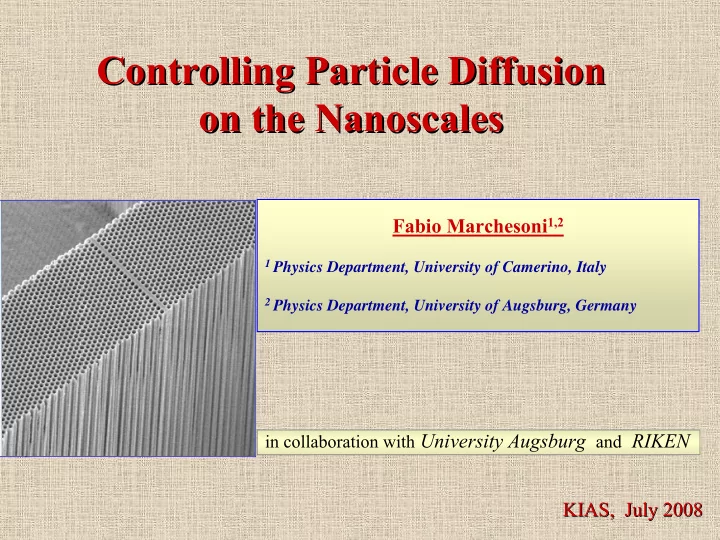

Controlling Particle Diffusion Controlling Particle Diffusion on the Nanoscales Nanoscales on the Fabio Marchesoni 1,2 1 Physics Department, University of Camerino, Italy 2 Physics Department, University of Augsburg, Germany University Augsburg RIKEN in collaboration with and KIAS, July 2008 KIAS, July 2008
Brownian Motors Brownian Motors Astumian & Hanggi, Physics Today (2002) Flashing ratchet : substrate switches on and off periodically Role of noise : rectification is assisted by noise kinesin Diffusion Diffusion ATP hydrolysis ‹x 2 › t α = 2 D α spread around mean α = 1 normal diffusion Impacts efficiency : long / ‹|v|› 2 observation times t obs > 2 D 1
One- -species mixtures species mixtures One PRL 01 PRL 99 Bras & Kets PRL 04 Binary mixtures Binary mixtures Repulsive interaction: feel ratchet potential; don’t.; both species get rectified in opposite direction
Diffusion Enhancement Diffusion Enhancement Model : single Brownian particle in a L=2 π tilted washboard potential ′ = − γ & − + ξ + μ =v/F v ∞ =F/ γ m x x V ( x ) ( t ) F & & ξ (t): thermal noise 〈ξ〉 = 0, 〈ξ( t )ξ(0)〉 = 2γ kT δ( t ) V(x)=V(x+L): periodic substrate regime ( m = 0, γ = 1 ): most used for applications Overdamped = − + + ξ x sin x F ( t ) & one depinning threshold: F 3 ‹x 2 (t)› ̶ ‹x(t)› 2 = 2 D t normal diffusion with D = D (F,T)
Numerics : D(F) peaks at F = F 3 kT=0.01 to compare with free diffusion D 0 = kT [Costantini, FM, EPL 48 (1999) 491] D/D 0 Renewal process : diffusion due to kT=0.1 uncorrelated hops between adjacent wells Cox' formula yields: F/F 3 ‹t n (a → b)› n -th moment of the a → b FPT in good agreement with numerics. [Reimann et al, PRL 87 010602 (2001)]
Underdamped regime: effect further enhanced [Costantini, FM, EPL 48 (1999) 491] γ = 0.01 kT=1 γ = 0.1 Threshold effect: peaks located by approximate formula Consequence : diffusion enhancement occurs at current onset, eg, in ratchet devices; efficiency gets degraded.
Single- -File Diffusion File Diffusion Single Constrained geometries : from 1D to “narrow” channels. Single file (SF) : N non-passing particles diffusing over a line of length L: N,L →∞ with ρ = N/L = const [Jepsen gas, 1965] Initial v i and x i : randomly distributed Thermal noise: OFF (ballistic SF); ON (stochastic SF) ballistic SFD: normal diffusion SFD : the diffusion of a single particle gets suppressed; independently of F stochastic SFD: anomalous diffusion D with F D = √ D 0 / π [Harris 1975, Percus 1974]
SFD Enhancement SFD Enhancement V(x) L Corrugated walls : ion channels, zeolites, laser traps, etc (2 π x/L)] V(x) = d[1– cos Anomalous diffusion : ‹ Δ x 2 (t)› √ t/ ρ = 2F D = √ D(F) / π with F D F=1 F=1 D for a single particle driven on a periodic substrate F=0
Entropic Effects Entropic Effects W max 2D, 3D geometry: suspended Bona fide point-like Brownian particles in a “narrow” channel. ∝ kT Channel radius : w(x) = a cos(2 π x/L)+b W max = 2(b+a); W min = 2(b-a) V eff (x) Approximate reduction to 1D [Zwanzig 1992, Reguera Rubi 2001] • P(x,y,z;t) → P(x;t) A(x) • ±w(x) boundaries & V(x) = 0 → V entropic (x) = – kT ln A(x) π w 2 (x) (3D) with A(x) = 2w(x) (2D); (x) = T/[1+w'(x) 2 ] α • T → T eff α = 1/2, 1/3
Entropic Diffusion Enhancement Entropic Diffusion Enhancement Replacing V entropic (x) and T eff (x) into Cox' formula fits closely numerics Deviations for large F/T : asymptotes ≠ 1; particle piles up against bottlenecks [Hanggi et al, 2006, 2007] kT = 0.01, 0.1, 0.2, 04 μ L=2 π a/L=1; b/L=1.02
Resonant Diffusion Resonant Diffusion • flashing substrate – ATP power strokes, optical lattice traps, etc 2 x 0 (t) • side-wise sieves – by unbiased forcing = − − + + ξ x sin[ x x ( t )] F ( t ) & 0 with residence time τ with x 0 (t) = ± x 0 ; either periodic or random • kicked particles: by x → y = x – x 0 (t) = − + + + ξ y sin y F ( t ) F ( t ) & kick (t) = (–1) n x 0 δ (t with residence time τ with F kick – t n ); either periodic or random
Diffusion coefficient τ → ∞ : kicking is irrelevant, τ → 0: potential gets renormalized – cos x → – (cos x 0 ) cos x D (F=0) for the relevant potential amplitude D = (L/2) 2 /2 τ diffusion peak Resonant diffusion: τ ~ 1: particle hops right/left by steps π + and 2( π -x 0 of 2x 0 ); hence π - D = L 2 /(2 τ) π + π + (1 – ) π + , π right/left probabilities –
Conclusions Conclusions Work done also in collaboration with: Nori and Savel’ev (RIKEN): PRL 91 010601 (2003); 92 160602 (2004); Taloni (now IoP-AS, Taiwan): 96 020601 (2006); 97 106101 (2006); Borromeo (INFN, Perugia): 99 150605 (2007) Diffusion plays a crucial role in the control of particle transport at the nanoscales. Relevance for applications in nanotechnology . RMP 2009
Recommend
More recommend